From terror to tourism: How Georgia's Pankisi Valley rewrote its story
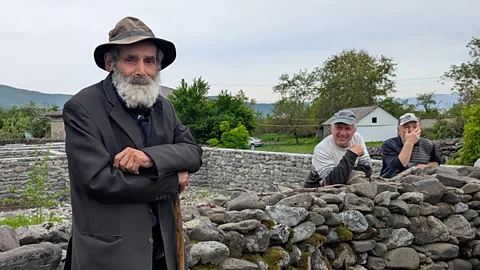 Eloise Stark
Eloise StarkLong overshadowed by headlines of extremism, Georgia's Pankisi Valley is now welcoming travellers with Sufi rituals, mountain trails and home-cooked Kist food.
The chants start quietly. Sitting cross-legged in a circle, the women respond to one another in softly sung words of Arabic and Chechen. Words praising God, words calling for peace in the world. As their voices rise, they stand up. They begin to clap.
"ā ilāha illa ʾllāh..."
Carried by the growing rhythm, they start moving in a tight circle. Beads of sweat form on the forehead of one elderly woman who is a head shorter than the others. She keeps going. The spinning and chanting get faster and faster, louder and louder, building to a meditative, whirring trance. Then the singing breaks, and the women embrace each other.
This is dhikr, a Sufi ritual that means "remembrance" in Arabic and is meant to bring the soul closer to Allah. Duisi, this small village in Georgia's Pankisi Valley, is the only place in the Caucasus where women perform dhikr in the mosque as men do. In a corner of the room, a small group of visitors – from the US, Europe and the Middle East – watches on.
Two decades ago, few tourists would have dared set foot in Pankisi Valley. This narrow green dale in the Caucasus Mountains, home to ethnic Kists (a Muslim community with Chechen roots), had landed a reputation it struggled to shake. News reports labelled it "notoriously lawless" and travel advisories warned people to stay away. Today, local families are determined to do away with those stereotypes by hosting tourists and showing them the real Pankisi Valley: a place where people ride horses, make dumplings and sing echoing songs of peace and devotion.
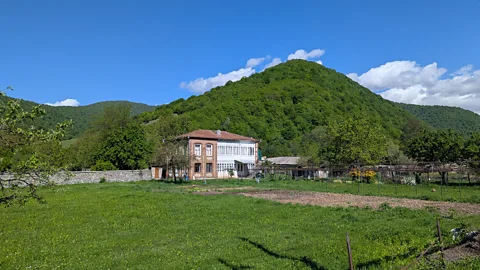 Eloise Stark
Eloise StarkPankisi Valley's troubled reputation dates to the early 2000s when it became a refuge for Chechens fleeing war in Russia. The Kists speak a Chechen dialect, and the valley is located just across the border from Chechnya, making it a logical destination for many refugee families.
Among the civilian refugees were some militants and former soldiers, prompting unfounded rumours that members of Al Qaeda – and even Osama Bin Laden – were hiding in the valley. Under pressure from Russia and the US, the Georgian government launched anti-terrorist operations in the marginalised region. At the same time, the government's efforts failed to address the local community's economic and social struggles, as the arrival of thousands of refugees placed strain on already limited resources. "It was only through anti-terrorist special operations that the state reminded the residents of its existence," wrote Georgian academics Maia Barkaia and Barbare Janelidze in a 2018 paper.
The so-called "Pankisi Crisis" eventually subsided, and most Chechen refugees left the valley for Central and Western Europe. But years of economic and social pressure, teamed with neglect by the central government, opened the doors for ISIS influence in the 2010s, when its propaganda machine started preying on disenfranchised young people from around the world. Between 2010 and 2016, an estimated 50 to 200 people left Pankisi Valley for Syria, lured by ISIS messaging. The most infamous was Abu Omar al-Shishani, a top ISIS commander, whose origins reignited global media interest in Pankisi – once again casting it as a terrorist hotspot.
Pankisi's dangerous image persists to this day, despite the fact that crime rates are very low. In 2020, the Danish Ministry of Immigration noted in a report that: "There is not a high criminal rate in Pankisi. The region is very calm." Locals often joke that the police have nothing to do all day but drink tea.
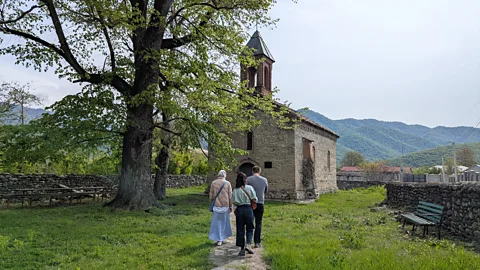 Eloise Stark
Eloise StarkPlan your trip:
How to get there: Daily minibuses depart from Tbilisi's Ortachala Station for Pankisi.
When to go: From May to October to avoid the cold winter months. Some guesthouses close from December to March.
Where to stay: Pankisi Valley has nine guesthouses, located in the villages of Duisi and Jokolo. They are run by local families who will introduce you to Kist hospitality and provide wonderful home-cooked food.
What to do: Take a guided tour of Pankisi's villages to learn more about local culture. Climb up to the old watchtower for sweeping views over the valley. Attend the dhikr ceremony, held every Friday at noon in the old mosque of Duisi village. Go hiking in the Batsara Nature Reserve.
"When I started university in Tbilisi, my classmates still had these stereotypes about Pankisi being unsafe," says Fatima, who works as a tourist guide when she's back home in Duisi. "I had to explain to them that that time is long gone. This is a very peaceful place. That's what I love about it."
As part of a cultural walking tour of Duisi and Jokolo villages, Fatima leads me up a steep trail to a crumbling old watchtower with sweeping views. Around 3km wide, the vivid green valley contains a string of villages along a river. Cows wait at the front gates of intricately carved wooden houses with rows of windows on the upper floors that let in the gentle spring sunshine.
Around the villages, sheep-dotted fields climb into forest-covered hills. To the north, I see the snow-capped peaks of the Caucasus Mountains. Out of sight, to the south, are the sun-drenched vineyards of Kakheti, Georgia's biggest wine-producing region.
"People here love the outdoors. In summer, we take picnics up the mountain or go horse riding in the hills," Fatima says. "I don't think I could ever live in the city, coming from a place like this."
I could understand why. Pankisi Valley feels idyllic. After the last village, the road simply stops; the end of Georgia marked by a wall of mountains. I feel like I'm at the edge of the world, wrapped in a cosy coat of green hills and blue skies. The friendliness of locals adds to this feeling of comfort. Children run up and ask, in perfect English, where I am from, and show me tricks on their bikes. Adults give me cups of herbal tea and gesture directions at me whenever they think I might be lost.
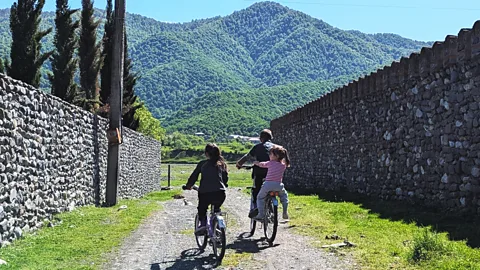 Eloise Stark
Eloise Stark"A lot of people who visit Georgia want to experience the country's legendary hospitality. Pankisi is one of the places where you can still find that," says Emily Lush, the creator of Wander-Lush, a travel resource for Georgia. "In terms of the culture, the traditions, the cuisine – there is nowhere else like it."
As Sufi Muslims, the Kist population has different traditions from Georgia's mainly Orthodox population. Spiritual music and rituals are an integral part of everyday life, and the food and language of the valley are also distinct, brought across the mountains by Chechen migrants who settled in the valley in the early 19th Century.
And yet, despite the valley's unique culture, it hasn't been easy to attract tourists here. This isn't due to remoteness. Pankisi Valley is just a two-and-a-half-hour drive north-east of Tbilisi and less than 20km from the town of Akhmeta, which attracts many tourists due to its winemaking.
Nazy Kurashvili was the first to encourage travellers to make it those extra few kilometres to Pankisi Valley. She opened the area's first guesthouse, Nazy's Guesthouse, in 2013. She then spent years convincing the Georgian Tourism Ministry to include information about Pankisi Valley on their website, and invited foreign ambassadors to the guesthouse to show them the area. In 2018, she set up the Pankisi Valley Tourism and Development Association to help others start tourism businesses.
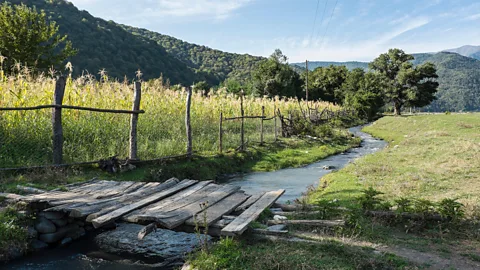 Alamy
AlamyLittle by little, word got out about this picturesque valley. Pankisi was featured in Lonely Planet's 2020 Georgia, Armenia & Azerbaijan guidebook, and tour companies such as Intrepid Travel began including it in their itineraries.
More like this:
• Georgia's daring, death-defying pilgrimage
Today, hundreds of tourists visit Pankisi each year – and there is plenty waiting for them when they arrive. Visitors can join horse treks or hikes into the mountain and visit heritage houses, historic churches and mosques. They can take cooking classes in Kist cuisine or join felt-making workshops. The village of Duisi has a small ethnographic museum and hosts the weekly Sufi dhikr ceremony. The nearby Batsara Nature Reserve is home to one of the world's largest and oldest yew forests, where rangers can organise hikes and birdwatching excursions.
"Tourism has played an important role in breaking down the negative stereotypes that surround the valley," says Lush. "Most importantly, tourism has given people a chance to speak for themselves."
One woman who has seized the growing opportunities in the valley is Khatuna Margoshvili, who spent several years working abroad to save enough money to open a guesthouse back home. "I love hosting people," she tells me. "Some just stay in the garden. Others want to explore. And lots of them want to learn how to cook."
 Eloise Stark
Eloise StarkKist cuisine, like its culture, is a mix of Chechen and Georgian influences, with ingredients drawn straight from the valley: homegrown vegetables, local cheeses and honey. The most popular dish is zhizhig galnash, a pasta-like dough served with melt-in-the-mouth lamb and ground garlic. Another favourite is khinkali, traditional Georgian dumplings, except here they are stuffed with nettles rather than meat.
Back at Nazy's Guesthouse, the table is laden every night with Kist dishes as well as jugs of locally brewed alcohol-free beer made from rosehip. Dinner is a communal affair. Guests sit around a long table and share stories from the day's adventures: hikes through ancient forests, horse treks up past the snow line, cultural tours or cooking lessons. Many guests extend their stays to have one more night tucked away in the valley. Just a little bit longer to relax, ride a horse, fold a dumpling or pour another glass of rosehip beer.
--
If you liked this story, sign up for The Essential List newsletter – a handpicked selection of features, videos and can't-miss news, delivered to your inbox twice a week.
